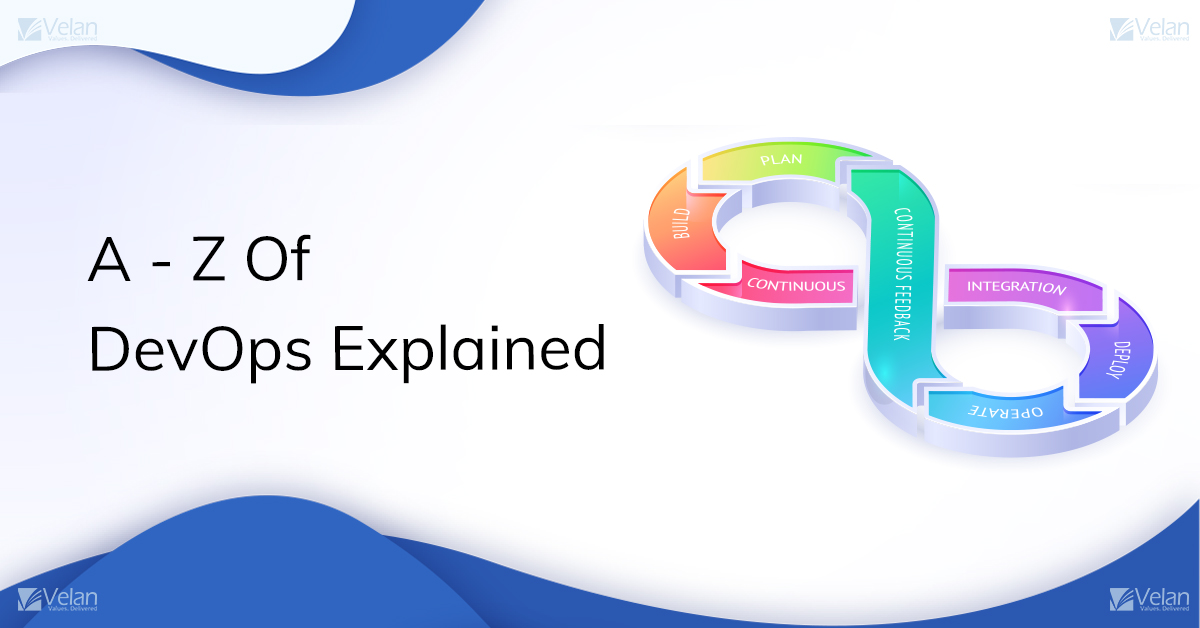A – Z Of DevOps Explained 23 Feb 2021

Before we dive into DevOps, let us understand what led to the invention of DevOps and the strategies used before it. There were several conventionally used software development methodologies like the Waterfall and the Agile methodology.
Waterfall Methodology
It was the first public life cycle model introduced in 1970 by Royce. It is a software development method that is linear and sequential, and it has distinct goals for each stage of development. It is called the waterfall model because the application goes to the next stage only when the previous state is complete.
The requirement for App > Design > Building > Testing > Deploying > Maintenance.
Limitations:
- It is difficult to go back and change the application once it is in the testing stage (in case of any bug, the operations team will have to go through the entire source code)
- There are high risks and uncertainty involved.
- It is not suitable for a project with a moderate to high risk of changing. For example, the time is taken by the developer to complete a project against the changing market needs.
Agile methodology
Agile methodology is where the development and testing can happen simultaneously and continually. The project is siloed into several iterations with the same duration. At the end of each iteration, there must be a product or a result.
Limitations:
- The development team was agile, but the operations team lacked stability. It was because of the inconsistency in the computing department.
The restrictions in both the above-stated methodologies led to the genesis of DevOps.
It became the single go-to solution to both issues.
What is DevOps?
DevOps is the amalgam of Development and Operations.
DevOps is a software development strategy that bridges the gap between development and operations. It is not a tool, it is not software, but it is a philosophy. It is a group of concepts put together in a single practice. It is not a technology but a methodology. It is a practice where the engineer participates in the entire life cycle of a product starting from design to production support. It is a methodology to integrate the development and operations team.
It uses productive tools to assist teams reliably and quickly innovate and deploy for their customers. These tools are meant to automate manual tasks, help teams handle crucial environments, and give engineers control of the high-velocity pace.
The diverse stages involved in DevOps are:
- Planning the next step of the product’s development
- Building the code
- Testing and deploying to the production environment
- Continuously delivering the product updates
- Monitoring and logging software performance
- Gathering or collecting customer feedback
How DevOps works?
In the DevOps model, the development and the operations teams will no longer work individually but collectively, as a team. These two teams will be united into a single team where the engineers will work across the entire application lifecycle, from coding and test to deployment to operations, and build a range of skills not restricted to a single function.
In some DevOps models, security teams and quality assurance may also work together with development and operations and lead to the completion of the application lifecycle. Security is the key for everyone on a DevOps team. The teams unite to automate practices by using a technology stack and tools that will help them operate and complete applications quickly. These tools will also help engineers to accomplish tasks that otherwise would involve help from other teams.
Why does DevOps matter?
Software and the digital world have reconstructed the businesses – from entertainment to shopping to banking. The software industry has extended its support beyond an application, and it has become an important component to operate every business. Companies can interact with their customers through software or applications delivered as online services across all screen sizes and devices. It is also leveraged to improve operational efficiencies by rebuilding the value chain, like operations, statistics, logistics, and communications.
DevOps methodologies
DevOps is the direct lineage of agile software development. Owing to its continuous need to keep abreast with the improved speed in software development and throughput agile practices, the expansion in agile development underlined the obligation for a more holistic approach to the software delivery life cycle, resulting in DevOps.
“Agile development” is the blanket term for various iterative software development methodologies, many of which have transferred to DevOps:
- Scrum — a structure where end users can attend to complicated adaptive problems while delivering the highest value products.
- Kanban — a practice for handling product creation that focuses on continual delivery while not putting any pressure on the development team. Similar to Scrum, Kanban is a process formulated to aid teams to work together more efficiently and effectively.
- Scaled Agile Framework (SAFe) — a group of workflow patterns to help organizations in scaling agile and lean methods. SAFe aims at addressing problems that occur when scaling more than a team.
- Lean development — a rendition of lean manufacturing practices to the software development space. It provides a conceptual structure, principles, and values, best practices derived from experience, that bolster agile enterprises.
- Extreme programming (XP) — a software development methodology that aims to enhance the software quality, responsiveness to its evolving customer needs. To enhance productivity and constantly help customers, it advocates introducing checkpoints and recommends periodic releases in the software development cycle. Exhaustive code review, flat management structure, unit testing, simplicity of code, open to change as per customer’s requirement and changing market trends, understand the problem better, the regular customer connects, etc. are a few important elements of XP.
DevOps Practices
Several important practices will help organizations innovate faster through innovation, streamlining, and scaling the software development management process.
The most significant practice is to release small updates frequently. These updates are incremental when compared to the traditional release practices. Organizations using DevOps will be able to deploy updates regularly and frequently.
The practices are:
- Continuous Integration: Continuous integration (CI) is a software development practice where developers periodically combine their code changes into a central repository, followed by automated builds and tests. The goals of CI are to discover and correct bugs faster, enhance software quality, lessen the validation time, and release new software updates.
- Continuous Delivery: Continuous delivery (CD) is a software development practice where code changes are automatically built, tested, and prepared for a production release. It adds details to continuous integration by deploying all code changes to a testing environment and/or a production environment after the build stage. With a properly implemented continuous delivery, developers will have a deployment-ready build artifact.
- Microservices: The microservices architecture builds a single application like a set of small services. Each service operates in its process and communicates with other services mostly through an HTTP-based application programming interface (API). They are built around business capabilities where each service is mapped as a single purpose.
- Monitoring and logging: By capturing and studying logs created by applications, the DevOps teams can comprehend how software changes or updates may affect users.
How will you benefit, as a company, with DevOps?
●Speed
With DevOps, your team can operate at a high velocity so you can innovate and complete tasks for your customers faster, accommodate shifting markets better and become more efficient with business results. The model will allow your developers and operations teams to achieve these results with accurate quality and precision.
For example, continuous delivery and microservices will enable teams to take ownership of services and release updates to them swiftly.
●Security
With this model, you will be able to move quickly with greater control and preserving compliance. DevOps model is synonymous with assured security as it uses automated compliance policies, well-defined controls, and configuration management techniques.
For example, with infrastructure as code and policy as code, you can detail and monitor compliance at scale.
●Reliability
You can be certain of the quality of application updates and infrastructure changes. It will give you the guarantee to deliver at a rapid speed while maintaining a satisfying experience for your end-users. DevOps practices like continuous integration (CI) and continuous delivery (CD) can be continuously used to test and confirm that every change is safe and functional. Monitoring and logging methods will help you be in the know of the application’s performance in real-time.
●Rapid Delivery
You will be able to improve the frequency and release speed. It will give you more time to innovate and improve your product better and faster. The quicker you can release new features and fix bugs, the faster you will be able to attend to your customers’ needs and build competitive business advantage. Continuous integration and continuous delivery are the methods that automate the software release process, from build to deploy.
●Scale
You can scale, streamline, operate and maintain your development process and infrastructure. Automation and consistency will help you handle evolving and complex systems efficiently with informed risk.
For example, infrastructure as code will help you manage your build, development, testing, and production environments efficiently.
●Improved Collaboration
With DevOps in practice, you will be able to build better teams under a DevOps cultural model, that emphasizes ownership, accountability, and improved communication. Developers and operations teams will be able to associate closely, combine their work, break siloes, increase communication, share many responsibilities, and display ownership for their individual and team efforts. It will eliminate inefficiencies and save time.
For example, the handover and completion periods between tasks will be lesser and informed, ownership quality will be improved where every practice environment will be referred before beginning the next task.
Takeaway:
DevOps is a movement that is here to stay and revolutionize how industries and businesses will operate in the future. Building a secure and reliable DevOps model is a journey. It is revolutionizing how the once individual teams are better collaborating now and getting work done efficiently and in a better manner.
Velan is an ardent believer of DevOps and advocates for their clients to adopt the DevOps model for a successful organization. We help teams at every stage of the DevOps lifecycle by offering guidance and support on best practices. We follow the DevOps practices, frameworks, processes, workflow to build security and reliability in our clients’ software development lifecycle; thereby reducing friction, heavy costs, ensuring compliance, minimizing risks, and releasing updates regularly.





